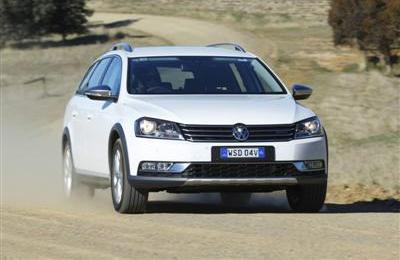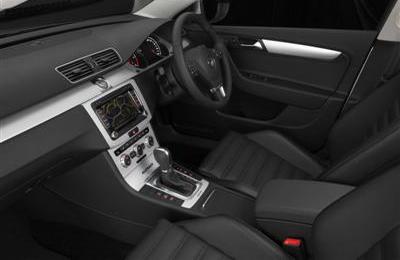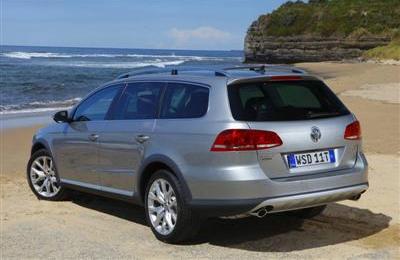|



Volkswagen Passat Alltrack Pricing*
Passat Alltrack 6 Speed DSG $47,790*
|
|
|
Volkswagen Passat Alltrack released
Home >
News >
Volkswagen
Recent new car releases ..... here
Upcoming new car releases ..... here
23rd November, 2012
• Higher ground clearance, new off-road design
• 4MOTION all-wheel drive and DSG as standard
• Loaded with features and a sub-$50k pricing
Volkswagen is extending the Australian Passat model series with another variant: the Passat Alltrack.
This new version is offered as a Wagon, and closes the gap between the conventional Passat wagon and SUVs such as the
Mitsubishi Outlander and Ford Territory. The rationale is clear: many drivers who use their car as a towing vehicle, or
in light off-road situations, desire a versatile and roomy passenger car that has rugged-like qualities. Volkswagen has
developed the Passat Alltrack for this clientele. In comparison with the familiar Passat wagon, the new model is defined
by new, SUV-style bumpers – with wheel well and side sill flares. Its greater off-road ramp angle, approach angle,
departure angle and higher ground clearance all make the Volkswagen Passat Alltrack an SUV alternative for driving on
unsealed roads.
Power and Performance
Featuring the Volkswagen 125 kW TDI engine, the Passat Alltrack also comes standard with 4MOTION all-wheel drive and a
dual clutch transmission (DSG). While the Alltrack’s turbocharged diesel engine makes 350 Nm of torque, the Alltrack
maintains the kind of frugal fuel consumption Passat diesel owners have come to expect, with a combined fuel cycle of
6.3 l/100 km# (CO2 = 166 g/km# CO2).
High torque:
The new Passat Alltrack is designed for towing capacities up to 1,800 kg (braked) and for handling offroad situations.
That is why the Passat Alltrack uses the torque-strong turbocharged engine with a maximum torque of 350 Newton metres
requiring no more than 1,750 - 2,500 rpm to achieve its maximum torque output.
Protected engine:
When driven over unpredictable terrain, the engine is protected by a solid engine underbody guard made of a steel
plate. This protects the engine, gearbox, oil sump, exhaust system (front section) and various hoses from damage.
Parameters of off-road capability:
The Passat Alltrack is almost the same length as the Passat Wagon at 4,881 mm, and its width is an identical 1,820 mm
despite the wheel arch flares. The vehicle’s key off-road parameters are telling: compared to the Passat Wagon, its
ground clearance has been increased to 165 mm. The front approach angle has increased from 13.5 to 16 degrees, and at the
rear, the departure angle has increased from 11.9 to 13.6 degrees.
Another parameter that is no less important in off-road situations is the ramp angle for crossing over a hill; this
value was improved from 9.5 to 12.8 degrees.
Visual Modifications
Good styling always visually reflects a car’s conceptual parameters. In the case of the Passat Alltrack, these include
the vehicle’s more versatile performance parameters for driving on rough terrain than would be found on a conventional
wagon. The declared goal of the designers was to reflect its competence off-road with very functional styling. In the
area of the side profile, for example, the classic wheel housings and side sill flares are used, which are functionally
oriented and offer rugged protection. The elements do not simply have the appearance of being tacked onto one another,
rather they are harmoniously integrated into the Passat’s overall design. The same applies to the new design of the
bumpers. Firstly, they show greater volume and are very rugged in construction; secondly, they completely fit in with the
styling of the Passat. In interplay with the higher ground clearance, the underbody protection panels in stainless
steel-look are integrated front and rear, projecting an overall link between the passenger car and SUV design.
Dimensions in Detail
At a length of 4,881 mm, the Passat Alltrack is slightly longer than the Passat Wagon (4,771 mm). Despite the wheel
housing arches, its width remains identical at 1,820 mm. The Passat Alltrack has a ground clearance of 165 mm, an
approach angle of 16 degrees and a departure angle of 13.6 degrees. No less important in off-road use is the ramp
breakaway angle, crucial in crossing the crest of a hill; here, the value has been improved from 9.5 to 12.8 degrees.
Off-road Driving Programme
Volkswagen SUV drivers are familiar with the ‘off-road driving programme’ on the Touareg. For the first time at
Volkswagen, this clever, multifunctional system is being transferred to a passenger car in the Passat Alltrack. The
driver activates this programme by pressing an Off-Road button on the centre console. An LED symbol in the instrument
cluster indicates when the system is ‘active’. Specifically, the settings for the safety and driver assistance systems
and DSG control are modified as follows:
Safety systems: The anti-lock braking system (ABS) is now characterised by higher thresholds for control intervals;
on loose road surfaces, such as gravel, a wedge of road substrate is formed in front of the tyres to decelerate the
vehicle even more effectively. At the same time, the electronic differential locks (EDS) react quicker to prevent wheel
spin at individual wheels. The engine’s torque control (ASR) is modified in parallel.
Driver assistance systems: Hill descent assist is automatically activated (when the off-road function is selected) at
a descent angle greater than 10 degrees; braking the Passat Alltrack while functions of the optional adaptive cruise
control (ACC) and Front Assist are deactivated.
Dual clutch transmission: A flatter accelerator pedal characteristic makes it easier to meter engine power in
off-road situations. At the same time, gear shift points are raised, automatically giving the driver a higher engine rpm
and therefore more power to work with. If the DSG selection lever is switched to the manual shift gate, the transmission
no longer upshifts automatically. The Stop/Start system and coasting function are also deactivated.
4MOTION all-wheel drive
The Volkswagen Passat Alltrack is delivered with 4MOTION all-wheel drive as standard in Australia. Normally, the front
axle is the primary drive axle in the Passat Alltrack 4MOTION; the rear axle only gets ten per cent of the drive torque,
saving on fuel. The rear axle may be gradually engaged – step by step – depending on the specific driving and road
situation. This is done via an electro-hydraulic all-wheel coupling. The advantage of the electronics: no engine speed
differences are necessary between the front and rear axles to activate the all-wheel drive coupling, because pressure is
built up via an electric pump.
Alltrack Standard Features
Along with the Off-road driving programme, modified chassis and body modifications, the VW Passat Alltrack is
characterisedby a whole series of specific feature details. These include the new ‘Valley’ type 17-inch alloy wheels (new
‘Canyon’ type 18-inch wheels are another option included in the Sport package) and a low tyre pressure indicator. Trimmed
in ‘chrome’ on the Passat Alltrack are the roof rails, window surrounds, door mirror housings and radiator grille.
Standard features also include front and rear underbody protection in stainless steel-look, fog lights, stainless steel
door sill plates with ‘ALLTRACK’ signature, comfort seats (Vienna leather appointed as standard, or optional Nappa
leather appointed as part of the Sport package), interior accents in ‘Titanium Silver’ (with ALLTRACK signature on ash
tray cover), pedals in brushed stainless steel and Dual Zone automatic climate control. Other ‘ALLTRACK’ signatures are
located at the front and rear of the vehicle. On the screen of the instrument cluster the new VW Passat Alltrack also
‘greets’ its driver with the ‘ALLTRACK’ signature. Visible from exterior are the decorative dual exposed chrome
tailpipes.
|
|
|

Self-Catering Holiday
Accommodation in
Denmark, WA
..... more
|
|
|
Safety features:
The Passat Alltrack has such features as eight airbags, daytime running lights and the ESP electronic stabilisation
programme. Additional standard features: fatigue detection and ESS Effective: automatic brake light activation under
severe braking. Ingenious: if the driver parks the Passat Alltrack and unbuckles the seat belt before the engine is shut
off, the electronic parking brake is automatically activated (when Autohold is selected), which prevents unintentional
rolling.
Child-friendly: standard Isofix fittings for suitable child seats
Convenience features: In the interior, standard features include various storage compartments (such as in the centre
console and roof liner console) and the analogue clock on the dashboard. Other standard convenience features: automatic
climate control, electro-mechanical steering assist, electric windows front and rear, outside temperature indicator,
electronic parking brake with auto-hold function and central locking (with wireless remote). There are also pockets on
the backrests, manual lumbar supports and electric backrest adjustment (driver’s seat). Multifunction leather-trimmed
steering wheel, leather-trimmed shift lever grip and carpet floor mats are also part of the standard specification. The
multimedia AUX-IN socket, automatic running light switching, automatically dipping rear-view mirror, Parking sensors for
the front and rear, safety-optimised head restraints with additional longitudinal adjustment and a rain sensor complete
the range of standard features.
Key Technologies of the Passat Alltrack
Fatigue detection:
This system detects waning driver concentration and warns the driver with an acoustic signal lasting five seconds; a
visual message also appears in the instrument cluster recommending that the driver take a break from driving. If the
driver does not take a break within the next 15 minutes, the warning is repeated once. Fatigue detection counteracts this
tendency. Right at the beginning of each car trip, the system analyses the driver’s characteristic steering behaviour.
The fatigue detection system then continually evaluates signals such as steering angle, use of the pedals and transverse
acceleration. If monitored parameters indicate a deviation from the steering behaviour recorded at the beginning of the
trip, then visual and acoustic warnings are produced. Independent of this monitoring, whenever the system is activated it
recommends a driving break to the driver after a certain period of continuous driving.
The assistance system does not warn in acute cases of ‘microsleep’; rather, fatigue detection aims to detect phases of
waning concentration even before this happens. Fatigue detection is standard in the Passat Alltrack.
Tyre pressure indicator:
The tyre pressure indicator system makes use of the wheel speed sensors of the ABS system for its operation. How it
works: when air pressure decreases in a tyre, this also reduces the rolling radius at that particular wheel; therefore,
the wheel turns faster at the same vehicle speed, and the system detects this deviation.
The Alltrack driver is warned via the tyre pressure indicator.
Nonetheless, the system does not relieve the driver of the responsibility for independently verifying correct tyre
pressure at regular intervals.
Optional Features
Optional Driver Assistance and Visibility package
Offering drivers additional levels of safety and assistance, the Driver Assistance and Visibility package includes
bi-xenon headlights with LED daytime driving lights with static and dynamic cornering lights, rear LED tailight and Lane
Assist, a lane departure warning system that reduces the likelihood of the vehicle leaving the lane. The Lane Assist
function monitors the road ahead with the aid of a camera which recognises lane markings, and takes corrective steering
action for up to eight seconds.
Side Assist including Lane Assist:
Also making a significant contribution to improved safety is the optional combination of Side Assist (lane-changing
assistant) and Lane Assist (lane-keeping assistant). Compared to the individual systems – the combination of Side Assist
and Lane Assist represents a functional extension and offers a significant gain in safety, due to its reliable and urgent
warning if a specific hazard is detected.
Here is how the two assistance systems operate as separate systems:
Side Assist makes the driver aware of vehicles located in the blind spot next to the Passat Alltrack or vehicles
approaching from the rear by flashing LEDs in the door mirrors.
Side Assist operates using radar sensors. Meanwhile, Lane Assist accesses signals from a camera; as soon as it becomes
evident that the driver is leaving the driving lane or is driving over the lane markings without setting the direction
indicator, Lane Assist countersteers.
Here is how the new systems operate together:
Side Assist Plus including Lane Assist merges the two assistance systems.
If another vehicle is located in a spot that is not visible to the driver during a lane change, the dual assistance
system pack warns the Alltrack driver via a flashing signal of the LEDs in the right or left door mirrors as well as via
a steering wheel vibration, and it simultaneously assists the driver with a corrective steering intervention. These steps
are taken regardless of whether or not a direction indicator is set. The combination of these two systems can make an
even more effective contribution towards avoiding collisions with other vehicles in the blind spot. However, the driver
still assumes responsibility for the entire process.
ACC plus Front Assist with City Emergency Braking:
Volkswagen designed City Emergency Braking as a functional extension of the automatic ACC (Adaptive Cruise Control)
plus Front Assist system. The new system operates over a speed range of up to 30 km/h, and it automatically initiates
hard braking if an imminent collision is detected. City Emergency Braking can reduce the severity of collisions in city
driving or even avoid a collision entirely.
Front Assist becomes active at a vehicle speed of 30 km/h. This system, which is integrated in ACC, helps to avoid
front-end collisions as an ‘alert front passenger’, even if ACC is turned off. It does this by continually monitoring the
traffic situation over a speed range of 30 km/h to 200 km/h with its front radar, warning the driver of any critical
situations. The system assists the driver even before a situation becomes critical by preconditioning the braking system
and sensitising the braking assistants.
As the risk of front-end collision increases, visual and acoustic warnings are initiated, and the driver is alerted to
a necessary intervention by a jolt of the brake pedal. If the driver reacts with braking that is too weak, the vehicle
automatically builds up as much brake pressure as necessary to avoid a collision. If the driver does not apply the brakes
at all after the warning pedal jolt, Front Assist brakes so that, under optimal conditions, the speed at impact is
reduced.
Overall, automatic adaptive cruise control makes driving very comfortable and convenient. On an open road, ACC can
theoretically accelerate the car to its top speed. If a slower vehicle appears in the car’s own driving lane, the system
automatically brakes to maintain the set distance ahead. The driver can calibrate this distance over various levels
within the legal range.
Park Assist, Generation II:
In contrast to first generation systems, which only supported parking parallel to the carriageway, the latest parking
assistant also assists in perpendicular parking – i.e. at right angles to the driving lane. The system is activated at
speeds up to 40 km/h by pressing a button on the centre console. The driver indicates the side of the carriageway for
parking by activating the indicator for that side. As soon as Park Assist detects a sufficiently large parking space –
utilising its ultrasonic sensors – assisted parking can begin: The driver engages reverse gear and then only needs to
accelerate and brake. The Alltrack handles the steering.
The driver is assisted by acoustic and visual cues on the multifunction display. While parking, Park Assist reduces
vehicle speed to seven km/h. For the first time, this system can also actively brake the car if a collision is about to
occur. Nonetheless, the driver remains responsible for braking, since the new braking function of Park Assist cannot
guarantee that damage will be prevented in all cases.
Vehicle Dynamics Systems
Adaptive chassis control:
Adaptive chassis control offers three programmes: ‘Normal’, ‘Sport’ and ‘Comfort’. These are selected by a button next
to the gearshift lever. Crucial here is the fact that adaptive chassis control is constantly working to improve driving
properties. This is because it continually adapts damping to road conditions and the driving situation. The system also
reacts to acceleration, braking and steering inputs. The system resolves the apparent conflict of goals between tight,
sporty tuning and a comfortable ride. The significantly enhanced comfort is perceptible to both driver and passengers.
Cargo Space
The cargo capacity of the Alltrack’s bootspace is 588 litres. Cargo capacity when seats are folded is 1,716 litres –
in this case, thePassat Alltrack is loaded up to the roofliner and to the backrests of the front seats. A cargo net
barrier may be mounted behind the first seating row and/or behind the second seating row to prevent luggage from entering
the passenger space when braking.
Other key data on the Alltrack cargo space: 719 mm tall cargo opening and 831 mm interior height; 1,000 mm width
between the wheel wells. Largest width in the cargo space: 1,014 mm. The loading surface of the Passat Alltrack when the
rear bench seat is folded down is a minimum 1,941 mm long.
Levers mounted in the trim on the right and left sides of the boot make it easy to unlatch the left and/or right
section of the 1/3 to 2/3 split backrest so that it can fold forward in a controlled way.
Volkswagen Passat Alltrack Pricing*
Passat Alltrack 6 Speed DSG $47,790*
Options
Metallic Paint $700*
Pearl Effect Paint $700*
Panoramic Electric Glass Sunroof $2,000*
Park Assist 2 $900*
Driver Assistance and Visibility Package $3,300*
Adaptive Cruise Control (ACC) and Front Assist with City EB $2,000*
Adaptive Chassis Control – 17” Alloy wheels $1,650*
Adaptive Chassis Control – 18” Alloy wheels $1,650*
12-way Electric Front Seats with Driver's Memory $1,500*
Anti-theft Alarm System $600*
Sport Package $2,800*
NOTE:
* Manufacturer's List Price (MLP) excludes dealer delivery fees and the numerous statutory charges (commonly known as
on-road costs). Additionally, please note that all prices, fees and charges are subject to change without notice, as are
the specifications.
# All fuel economy and driving performance data cited in this story are forecast values.
E&OE.
|